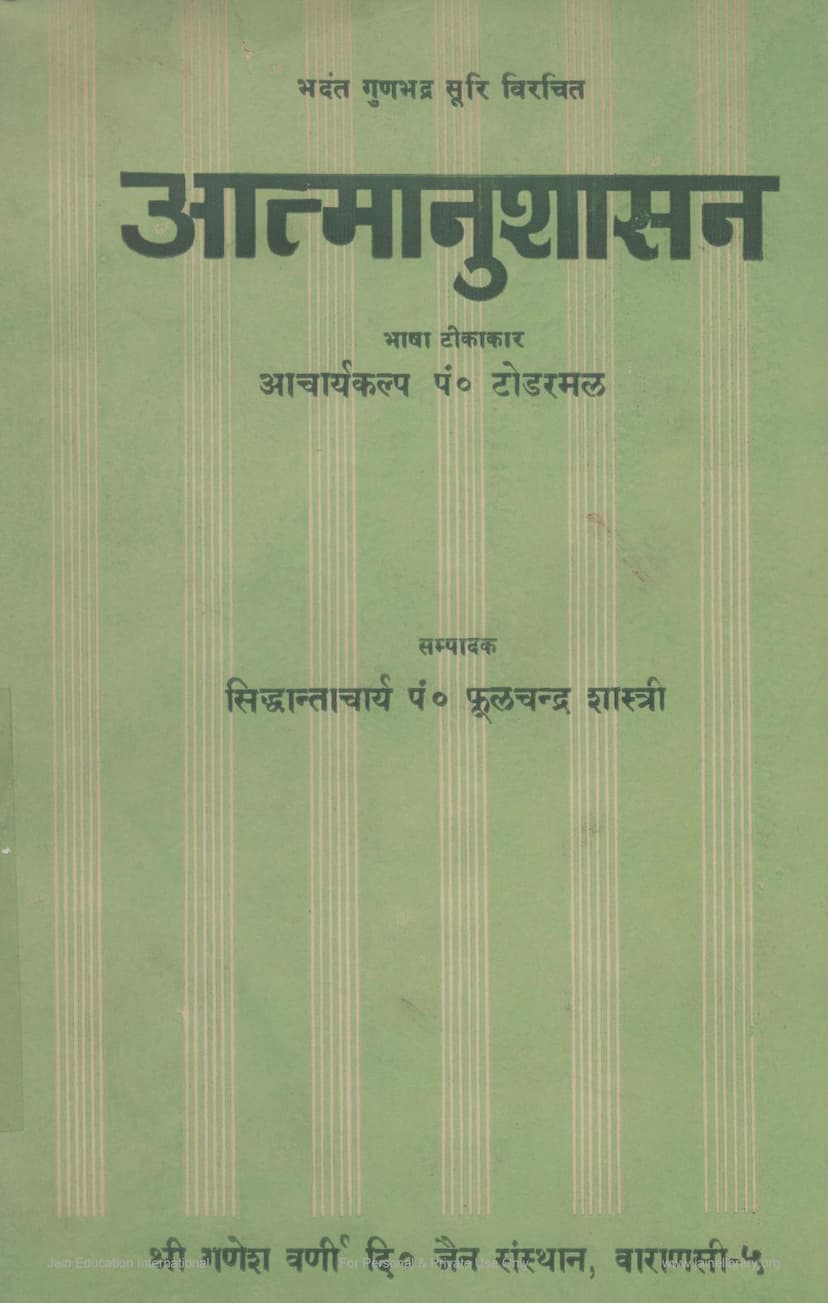Atmanushasan
Added to library: September 1, 2025

Summary
Here is a comprehensive summary of the Jain text "Ātmānuśāsana" by Pandit Todarmal based on the provided text:
Ātmānuśāsana: A Guide to Self-Discipline
"Ātmānuśāsana," a seminal work by the revered Jain Acharya Gunbhadra, is a profound treatise focused on the discipline and realization of the Ātmā (self). This summary is based on the Hindi commentary by Acharya Kalpa Pandit Todarmalla, edited by Siddhantacharya Pandit Phoolchandra Shastri.
Core Concepts and Themes:
- The Nature of the Ātmā: The Ātmā is central to Jain philosophy, described as intrinsically all-knowing. The ultimate goal, Moksha (liberation), is the attainment of this pure, all-knowing state. The Ātmā is eternal, without a physical body, and devoid of sensory attributes (color, smell, taste, touch). It is the doer of its own thoughts.
- Karma and Bondage: The Ātmā is perpetually clouded by Karma (actions), leading to a cycle of suffering. Good and bad deeds alike bind the Ātmā, resulting in the experience of both happiness and misery. This cycle is endless, perpetuating the soul's entanglement.
- The Path to Liberation (Moksha): "Ātmānuśāsana" meticulously details the path to break free from this karmic bondage and realize the Ātmā's true nature. This path is primarily achieved through:
- Samyak Darśana (Righteous View/Perception): The realization of the true self is considered the essence of Dharma. Without it, other virtues like peacefulness, knowledge, and character are considered useless.
- Samyak Jñāna (Right Knowledge): True and complete knowledge is obtained from scriptures (Āgama).
- Samyak Caritra (Right Conduct): Righteous conduct, which includes adhering to vows and ethical principles, is crucial for shedding karma.
- The Importance of Dharma: Dharma is presented as the ultimate guide and savior of the soul. It enhances happiness in times of joy and alleviates suffering in times of distress. Dharma is likened to a seed that yields future happiness.
- The Role of the Guru and Disciple: The text outlines the qualifications of a true spiritual guide (Guru) and a deserving disciple. A worthy Guru possesses comprehensive knowledge, detachment, equanimity, and the ability to guide others. A deserving disciple is one who is weary of worldly suffering, sincerely seeks true happiness, and is capable of understanding and following Dharma.
- The Dangers of Worldly Attachments: Worldly pleasures and attachments are depicted as illusory, like a mirage. Pursuing them leads only to exhaustion and dissatisfaction. Even "good" deeds (śubha karma) can contribute to the cycle of rebirth if they are performed with attachment, ultimately hindering liberation.
- The Role of Women (with caution): The text includes verses that caution men against the charms of women, highlighting their potential to cause downfall and distraction from spiritual pursuits. It is emphasized that these verses are not intended to degrade women but rather to serve as warnings to men who may succumb to their allure.
- Deterioration of Monastic Conduct: Acharya Gunbhadra expresses deep concern about the decline in character among monks (muni and sadhu). He laments the instances of misconduct and the lack of strict adherence to Dharma, a concern that remains relevant today.
- The Doctrine of Karma: The foundational doctrine of Karma in Jainism heavily influences the text. It emphasizes self-reliance and individual responsibility, as there is no supreme external power controlling the world.
- The Poetical and Philosophical Prowess: Acharya Gunbhadra's mastery of Sanskrit and his deep philosophical insights are evident throughout the text. He employs various meters and poetic devices to convey complex spiritual truths.
- Pandit Todarmalla's Commentary: The Hindi commentary by Pandit Todarmalla is credited with making "Ātmānuśāsana" widely popular. His insightful explanations, often providing purports where necessary, have made the text accessible and comprehensible to a broader audience.
- The Textual Basis: This edition is based on a 1778 AD manuscript, cross-referenced with older printed versions and other editions containing Sanskrit commentaries to ensure accuracy and completeness of the verses.
Key Teachings from the Text (as highlighted in the prologue):
- Verse 2: The book directs towards knowledge that destroys misery and leads to eternal happiness.
- Verse 4: Only a worthy teacher can explain Dharma for Moksha, and only deserving individuals can follow it.
- Verse 5 & 7: The text defines the qualities of a true teacher and an ideal student.
- Verse 9: The path to liberation begins with the understanding of scriptures (Āgama) which leads to right perception (Samyak Darśana), right knowledge (Samyak Jñāna), and ultimately righteous conduct (Samyak Caritra), culminating in the dissolution of all karmic bondages.
- Verse 15: Righteous perception (Samyak Darśana) is the essence of Dharma, without which other virtues are meaningless.
- Verse 18: Dharma should be practiced regardless of one's state of happiness or misery.
- Verse 21 & 26: Dharma is essential for acquiring happiness and acts as a savior.
- Verse 53 & 198: Warnings are given regarding the negative influence of women and the potential downfall of ascetics due to desires.
- Verse 149 & 166: Concerns are raised about the laxity in monastic conduct and the lack of fear of falling from spiritual heights.
- Verse 239-240: The text elucidates the ultimate renunciation of even "good" deeds (śubha karma) to achieve the purest state of the Ātmā.
Conclusion:
"Ātmānuśāsana" is a comprehensive guide for spiritual aspirants, offering practical guidance for self-discipline and the ultimate attainment of liberation. It emphasizes the profound significance of right perception, knowledge, and conduct, all rooted in the core principles of Jain philosophy and the unwavering pursuit of the Ātmā's true, pure nature. Pandit Todarmalla's commentary makes this profound text accessible, ensuring its enduring relevance for seekers of spiritual truth.